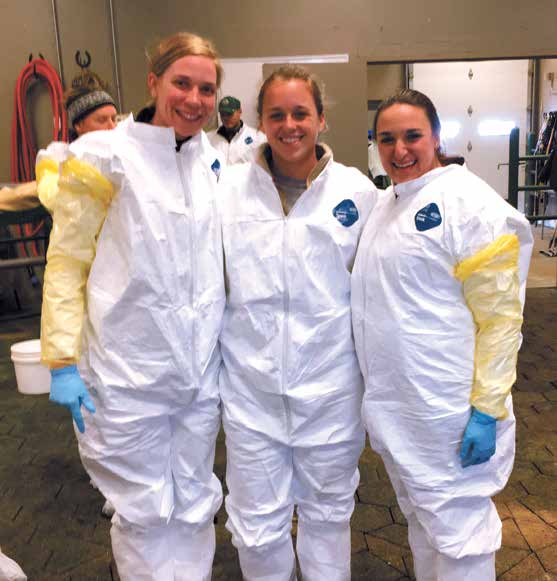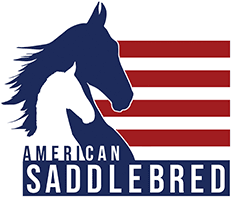
Continuing the Conversation - Education Resources
By Bob Funkhouser - Reprinted by permission from Saddle Horse Report - 5/16/2022
The next phase in continuing the conversation in the breeding world will deal with what education is available to the breeder so that they are not totally in the dark or dependent on veterinarians.
In the last article Melissa Moore and Todd Graham spoke about the different options for the physical process of getting your mare in foal; now we’re going to speak with those who can actually do those processes. Kim Graham, Emily Lee and
Whitney Shiflet have all been to breeding school and are now quite proficient at the goal of getting mares in foal.
Shiflet initiated the trip to Colorado State a few years ago and all three feel that they’ve greatly benefited from the education. Emily and Tre’ Lee own Prospect Lane in Versailles, Kentucky, and according to Emily they have 10-15 foals a year and stand two stallions. Most of the broodmares are farm owned but they do keep a few customer mares. “Initially when we had Top Of The Mark, Mary [Gaylord-McClean] wanted him collected and I felt like I could do that,” said Lee. “We had done live cover the year before and I had foaled out a few mares so I had a little experience. “We went to Colorado State because Whitney [Shiflet] found it, it was the right time of year and they offered what I wanted to learn. The doctors and techs were all great at Colorado State and we learned so much with hands on instruction. I learned to inseminate my own mares, prenatal care and how to deal with problems during foaling. It was all encompassing. I was really surprised about how much I learned about foaling. “I feel I benefitted greatly from this and use something I learned there nearly every day. The foaling part was the best for me. They taught us what the placenta should look like and what to look for that would be signs of a problem in the making. “This experience made me more aware of what to ask my vet and now I
can participate in discussions with her. Even if you only have one or two foals a year it’s worth it to take the course for
the foal care alone. We got to feel the position of legs and learned how to help and when to call the vet. It was all inclusive and pretty intensive.”
Kim Graham and her husband Todd own Royal Winds Farm and they have 20-25 foals a year, stand one stallion and have some 40 mares, a mix of farm owned and customers. “Whitney Shiflet is the one who told me about Colorado State,” said Graham. “My grandparents bred Hackneys and I was around it as a kid and I guess it stuck with me. Also, I worked for
Melissa Moore and helped her foal mares. As far as the school, I wanted to learn more. I wanted to get better at what I do. I love being the first person these foals see. That class goes through all of the mare and stallion stuff as well as foaling issues. Foaling is the complicated part of it. We got to simulate pulling a foal. We got to feel legs in the wrong position and learned how to try and fix it before something happens to the mare and foal. This hands-on part of the course is so good. I learned so much more that way.
“It is so smart to have this knowledge, especially if you live in a part of the country where you can’t get a vet at a minute’s notice or they don’t have vets that really specialize in reproduction. It can all go wrong really fast so it helps to know what to do and what to communicate to your vet.
“I know myself I save some $30,000 a year in vet expenses and a lot of time. I can manage the stallion, foal the mares, do it all. The vet doesn’t have to be here every day. We’re making money with this portion of the business instead of spending money. I have a really good vet at Haggards but only use her for what’s needed. She’s super busy and really appreciates that I can do a lot of this.
“I have also taken additional classes to learn how to ultra sound and pull embryos. It makes the process much smoother and the conception rate is much better. The vet can’t always get here right away. Now, we are on the mares’ schedules instead of the vets.
“We stand Joe Fabulous and we collect him and do live cover. His conception rate went way up with live cover. As an industry we don’t do enough of this.”

The ringleader of these three ladies and their continued education is Whitney Shiflet. She and her husband Matt have Shiflet Stables in Asheboro, North Carolina, and they have about 15 foals a year, stand two stallions, and keep 12-15 farm owned mares as well as some client mares.
“I have a degree in Animal Sciences and Reproduction,” said Shiflet. “When we got married our breeding program was getting bigger and the bills were huge. One of customers (Hank Gendron) is a vet and he told me, ‘There’s no reason you
can’t ultrasound your own mares.’ He had an extra machine and we traded out. I started playing around with it and going on You Tube learning what I could. A year later, Kim [Graham], Emily [Lee] and I went to Colorado State for their comprehensive program. And then later Kim and I went to Texas to learn embryo transfer.
“We don’t really have any reproductive vets near us and before I went to school, we might have gotten two out of five mares in foal. Now, three out of the last five years out of 20-plus mares I’ve gotten 100 percent of them in foal. Not all of them stayed in foal, but I got 100 percent in foal.
“I can ultrasound a mare 10-15 days in a row. I have the freedom to do as many as I want. I also learned that one of our biggest problems is with the extender. If a mare has an inflammatory response to the extender she is going to be full of fluid and won’t get in foal.
“All of this education is a big game changer. Besides having a better breeding program, it really helps on the finances. The mare foaling program was a great part of the Colorado State course. I’ve been able to get two foals out that otherwise wouldn’t have made it. We’re two hours to the closest clinic. I also learned a procedure called the Madison foal squeeze. This can literally change a foal that won’t stand or nurse, a foal that would be labeled ‘failure to thrive.’
“If you stand a stallion or have more than two mares a year under your care, these classes are a must and anybody interested in foaling mares at home should take it. It wasn’t cheap but if you save one foal it would all be worth it. Also, Colorado State has great resources online and in booklets that I use daily.”
It’s often said that timing is everything and in the case of ASHBA and this article, that statement rings true again. Recently the ASHBA Breeder Excellence Fund was created to help support American Saddlebred breeding programs in the United States. The Fund provides financial assistance to breeders to pursue educational opportunities related to breeding that
will advance their careers, promote sound breeding practices and further enhance the quality of American Saddlebred horses. Specifically, the ASHBA Breeder Excellence Fund supports attendance at educational programs related to breeding, such as Colorado State’s Equine Reproduction Continuing Education.
To apply, applicants must be a member of ASHBA. Grants of up to $1,000 are available. The amount awarded will depend on the financial plan provided as part of the application. ASHBA reserves the right to not award a grant in any given year if they determine that no candidate has met the criteria. Funds would then be held until the following year. If the grant recipient is unable to attend the program specified in his/her application, ASHBA must be notified as soon as possible. Approval for a change in the use of funds is at the discretion of ASHBA.
The online application form and all required documents must be submitted to ASBHA on or before June 1st of
each year. The grant must be used for training and programs that fall after the grant deadline date of June 1st and
within two years of that date.
“The goal of the ASHBA Breeder Excellence Fund is to not only educate breeders, but also help lower the costs
associated with breeding,” said ASHBA Executive Director David Mount. “The program is based on a successful
United States Dressage Federation program of the same name.”
